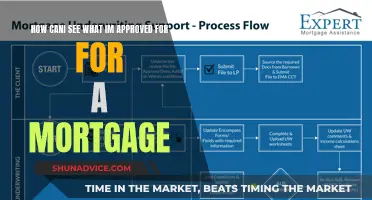
Balloon mortgages are a type of non-qualified mortgage loan that allows borrowers to pay low monthly payments for several years, with a large, one-time balloon payment at the end of the loan term. Balloon mortgages are not very common and are mostly used by borrowers in unique credit or financial situations, such as real estate investors or flippers. They are also more common in commercial lending than in consumer lending.
| Characteristics | Values |
|---|---|
| Commonness | Not common |
| Interest rates | Higher than typical mortgages |
| Borrowers | Real estate investors or flippers, high-net-worth individuals |
| Loan term | Shorter than traditional mortgages, typically 5–10 years |
| Monthly payments | Low or interest-only |
| Final payment | Large lump-sum payment, often at least twice as much as previous payments |
| Risk | High risk of default, foreclosure, or losing the home |
What You'll Learn

Balloon mortgages are not a common loan type
Balloon mortgages are not common because they can have higher interest rates than typical mortgages and other risky features. The biggest risk is that if the borrower cannot afford the large lump-sum "balloon" payment at the end of the loan term, they could lose their home. Because of this risk, balloon mortgages are not considered "Qualified Mortgages" and are not widely available from lenders.
In recent years, balloon payments have been more common in commercial lending than in consumer lending. This is because commercial lenders can keep short-term costs lower and take care of the balloon payment with future earnings. However, this strategy can be risky for individual homebuyers, as it assumes that their incomes will be much greater when the balloon payment comes due.
While balloon mortgages can make sense for some borrowers, they are generally not a common loan type due to their risky nature and the potential for high costs if the borrower cannot make the large final payment.
Mortgage Pre-Approval: What Can I Afford?
You may want to see also

Balloon mortgages are short-term loans
The appeal of balloon mortgages lies in their low initial monthly payments. During the loan term, borrowers pay a set interest rate, and their monthly payments remain unchanged. However, the loan term is shorter than the amortization period, resulting in a large outstanding balance at the end of the term. This final payment, known as the balloon payment, is a large lump sum that can be twice as much as the previous payments, often amounting to tens of thousands of dollars.
The balloon payment poses a significant risk to borrowers. If they cannot afford it, they may lose their home as the lender could foreclose the property. Additionally, balloon mortgages may have higher interest rates than traditional mortgages because they are non-qualified (non-QM) loans that do not adhere to the Consumer Financial Protection Bureau's standards for qualified mortgages (QM). Due to their risky nature and limited availability, balloon mortgages are not a common loan type, and most mortgage lenders do not offer them.
Despite the risks, balloon mortgages can make sense for borrowers who understand their unusual features and have a plan for managing the final payment. Some strategies to handle the balloon payment include refinancing the mortgage, selling the home, or paying more than the minimum amount during the initial period to reduce the principal balance.
Maximizing Your Mortgage: $20,000 Down Payment, How Much Can You Borrow?
You may want to see also

Balloon mortgages have higher interest rates
Balloon mortgages are a type of non-qualified mortgage (non-QM) loan that is not subject to qualified mortgage standards. This means that lenders can charge higher interest rates than the typical mortgage. Balloon mortgages are also associated with higher fees and other risky features.
The interest rates for balloon mortgages are often higher because they are not fully amortized over their term. Instead, the monthly payments are calculated as if the loan is a traditional 30-year mortgage, with either interest-only or a mix of interest and some principal for a set number of payments. This means that the monthly payments are much smaller than a fully amortized loan, but the remainder of the loan is due at once in what is known as a balloon payment. The balloon payment is often a very large sum, potentially leaving borrowers with a bill that is far higher than what they have been paying.
The higher interest rates of balloon mortgages can be advantageous to buyers who plan to be in the home for a short period, as they can borrow more than they otherwise could without feeling the full impact of high-interest rates. Additionally, the terms are typically five to seven years, after which the borrower can refinance, possibly at a lower interest rate. However, there is a risk that interest rates will be higher when the borrower needs to refinance.
Overall, balloon mortgages are considered uncommon and risky, and most mortgage lenders do not offer them. They are typically used by borrowers in unique credit or financial situations, such as real estate investors or house flippers who plan to sell the property soon after purchasing it.
The Subprime Mortgage Market: A Giant House of Cards
You may want to see also

Balloon mortgages are non-QM loans
A balloon mortgage is a type of non-qualified (non-QM) loan that allows you to borrow what you need to buy a home now and then pay the majority of it back at the end of the loan's term in one "balloon" payment. This type of mortgage is not a common loan type and is usually offered by small or private lenders.
Non-QM loans do not adhere to the Consumer Financial Protection Bureau's (CFPB) standards for a qualified mortgage (QM). These standards were established by Congress and the CFPB in response to the global financial crisis in 2007-2008. Because balloon mortgages are non-QM loans, they can have higher interest rates than typical mortgages and other risky features. For example, if you cannot afford the balloon payment, you may lose your home.
Balloon mortgages are typically used by borrowers in unique credit or financial situations, such as real estate investors or flippers who plan to sell the property soon after purchasing it. They can also be used by businesses in the construction industry to obtain short-term financing for projects without offering collateral.
The initial payment setup on a balloon mortgage can differ depending on the lender and loan. Some common structures include principal and interest payments, interest-only payments, or no payments at all during the initial period. The low monthly payments during the initial period of a balloon mortgage won't be enough to cover the total loan cost, resulting in a large outstanding balance that needs to be paid in full at the end of the loan term. This payment structure is called "non-standard amortization."
The Mortgage Market: A Giant in the Industry
You may want to see also

Borrowers can pay off a balloon mortgage early
It is not unusual for mortgages to include a balloon payment, which is a large sum due at the end of the loan term. While balloon mortgages can offer lower interest rates and monthly payments, they may not be suitable for everyone due to the substantial final payment. Borrowers who find themselves in a position to do so have the option of paying off a balloon mortgage early. Here are some things to consider if you're thinking about paying off your balloon mortgage ahead of schedule:
Understanding Your Mortgage Terms: Carefully review the terms and conditions of your mortgage agreement. Some lenders may impose prepayment penalties or have specific requirements for early repayment. Understanding any potential fees or restrictions can help you make an informed decision and plan your early repayment strategy effectively.
Building Equity and Improving Financial Position: Paying off your mortgage early can result in significant interest savings over the life of the loan. By making extra payments toward the principal balance, you build equity in your home faster and reduce the overall cost of borrowing. Improving your financial position through early repayment can enhance your borrowing power for future loans and strengthen your overall financial health.
Strategies for Early Repayment: There are several strategies you can employ to pay off your balloon mortgage early. Consider making regular additional payments toward the principal balance each month. Even small amounts can make a substantial impact over time. Another approach is to use windfalls, such as bonuses, tax refunds, or inheritance money, to make a lump-sum payment toward the principal. You can also consider refinancing to a different loan type that offers more favorable terms for early repayment, but be sure to weigh the costs and benefits of refinancing carefully.
Assessing Your Financial Situation: Before committing to early repayment, evaluate your financial situation and ensure that paying off the mortgage early aligns with your overall financial goals. Make sure you have a solid financial foundation, including adequate savings for emergencies and other financial priorities. Assess your income stability and ensure that your monthly cash flow can comfortably accommodate the increased payments required for early repayment.
By considering these factors, borrowers can make informed decisions about paying off a balloon mortgage early. While it may not be the right choice for everyone, early repayment can provide significant benefits, including interest savings, faster equity buildup, and improved financial flexibility. It is important to carefully review your mortgage terms, assess your financial situation, and seek professional advice to determine if early repayment aligns with your short-term and long-term financial goals.
Mr Cooper's Mortgage: How Big Is It Really?
You may want to see also
Frequently asked questions
A balloon mortgage is a loan with low initial payments, but it requires the borrower to repay the balance in full in a lump sum on a predetermined date.
Balloon mortgages are not common. They are usually short-term loans with higher interest rates than conventional collateralized business loans. They are most often used by borrowers in unique credit or financial situations, such as real estate investors or flippers who plan to sell the property soon after purchasing it.
Balloon mortgages can be risky because you’ll owe a larger payment at the end of the loan. If you’re considering a balloon loan, you need to think about whether and how you can make the balloon payment when it comes due. If you cannot pay the balloon mortgage, even if it’s on the last payment, you could face foreclosure.







